11 ways to give your garden a burglar and thief-proof makeover
You may have locked your doors and windows, installed a burglar alarm and prompted neighbours to keep a watch over your home while you’re on holiday – but have you considered how the style and design of your garden could help deter thieves too?
At this year’s RHS Hampton Court Palace Flower Show (on until July 8), designers Lucy Glover and Jacqueline Poll have a crime prevention garden that is both stunning and secure, a collaboration between crime prevention initiative Secured By Design with Capel Manor College and the Metropolitan Police.

The striking urban garden features green security measures, such as columnar trees and prickly plants, but also a calming atmosphere and soft relaxed planting, including beautiful perennials and grasses.
Latest images of our ‘Secured by Design’ garden under construction at at the #RHSHampton Court Flower Show in partnership with the Met Police @securedbydesign. #RHS2018 #college #London #gardendesign pic.twitter.com/qp7hGowktv
— Capel Manor College (@capelmanor) June 27, 2018
“Some 75% of all burglaries across the Met are via a rear garden. Those with criminal intention are looking for opportunity,” says PC Leslie Gipps, a Designing Out Crime Officer with the Metropolitan Police.

The finished Secured By Design garden
“What we do in Secured By Design is put in those layers which make it harder for the criminal to spend any real time trying to break in. They will just leave that garden and go for one that’s simpler.”
Want to add some crime-preventing layers to your garden? Here, the garden designers and Met officers recommend 11 ways to help deter criminals from targeting your property…
1. Prickly plants

Rrickly pyracantha should deter thieves
Create a hedge of prickly plants, such as Osmanthus, pyracantha or berberis, next to boundary fencing, which can act as a layer to deter thieves.
In the crime prevention garden, the designers used Osmanthus heterophyllus, a shrub with sharply toothed leaves (similar to holly) under the windows, Berberis thunbergii f. atropurpurea, with stems that bear spiky spines, and pyracantha, a dense spiky shrub which is great grown as a hedge. Pyracantha will grow in any soil and is fast-growing.
2. Green screens

Wire fencing could be the first line of defence
Boundary fences can be the first line of defence, and a good bet is a wire mesh which you can adorn with ivy or other ‘green screen’ – these look pretty but also act as a good deterrent. After all, a wire fence is unlikely to take someone’s weight.
Gipps explains: “By attempting the fence, thieves would draw attention to themselves and possibly leave their DNA behind. They know that, and can see it from the other side of the street. So it’s crime prevention through environmental design.”
3. Dusk-’til-dawn lighting
Install dusk-’til-dawn low-voltage lights to ensure visibility in the garden at night. Stone effect solar lights will provide additional lighting and sculptural interest throughout the garden. “If your garden is lit through the hours of darkness, people with criminal intention don’t want to come into a lit environment,” says Gipps.
Householders often ignore sensor lights, thinking they’ve been set off by a fox or a cat. “Ten-watt LED lights are fine. We prefer white LED lighting, but you can choose a less bright option,” Gipps adds.
4. Gravel around the house

Gravel around the house will alert you to uninvited visitors
Gravel is noisy when walked on, so having it around your property means you can hear any uninvited visitors approaching the house. It also alerts dogs.
5. Curtain planting

Verbena bonariensis provides excellent ‘curtain’ planting
“The aim is to have rich colour in the garden but not big solid shrubs that somebody can hide behind, so ideally grasses and other plants you can see through,” says Glover.
Light planting, such as grasses and ‘curtain planting’ with Verbena bonariensis and Sanguisorba canadensis, allows the homeowner to see through the planting.
6. Narrow trees

Sketch of the Secured By Design garden at Hampton Court
If you want to include architectural interest, use columnar-shaped trees, which are more difficult for intruders to hide behind and also difficult to climb.
7. Roses

Use roses in your burglar-busting design
Thorny roses can be used to great effect by training them over pergolas and other supports, which thieves might otherwise climb. The designers used rotating bars on their pergola to prevent thieves climbing. Roses will also give you scent and colour.
8. Green roof

Aloe could give a burglar a prickly surprise
9. Shed security

Don’t leave tools outside
Don’t leave tools outside, but also make it difficult for thieves to gain access to the shed, where you store them. Gipps explains: “The typical garden shed will come with a cheap padlock. We advocate that you have two locks – one a third up, the other a third down – with robust hinges and secure high-quality padlocks. You need robust hinges, coach-bolted through the fabric of the door.”
10. Secure garden pots

Make pots heavy
Thieves also use garden pots to break windows to gain entry. The best way to stop this is by using really heavy, large pots which are very difficult to lift. Keeping your plants well watered will help keep them heavy too.
11. Mark your property
Put your own forensic code on your garden items. Gipps recommends SmartWater (www.smartwater.com), a near-invisible, traceable liquid which gives your equipment its own unique forensic code, allowing items to be traced back to you, and the criminals back to the crime.
Officers have been out patrolling and handing out smart water kits to local residents on Vicrage Farm Road.@SmartWaterNews pic.twitter.com/9J7KIHpdx1
— Heston Ctrl Police (@MPSHestonCtrl) June 9, 2018
The code is registered to your home and stored on the SmartWater database. Once applied, it lasts for a minimum of five years, enabling stolen goods, if recovered, to be more easily identified and returned to the owner.
The Press Association
Latest posts by The Press Association (see all)
- Beatles documentary Let It Be to be released on Disney+ - April 16, 2024
- How to keep your money safe – as criminals ramp up AI tactics to steal consumer data - April 16, 2024
- Seasoned marathon runners give their best race day tips for first-timers - April 16, 2024
- What are heat pumps and could they help your home save energy? - April 15, 2024
- Trailer for Bridgerton season three teases new friends-to-lovers romance - April 12, 2024





















